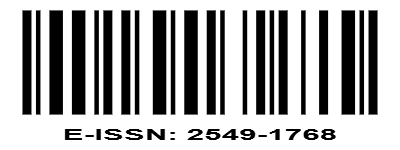IMPLEMENTATION OF 3D SOFTWARE TOWARDS REPRESENTATION MICROSCOPIC AND SPATIAL INTELLIGENCE OF PROSPECTIVE BIOLOGY TEACHERS
DOI:
https://doi.org/10.22373/biotik.v9i1.7758Keywords:
3D Software, spatial intelligence, representation, prospective teachersAbstract
The aim of this research is to find out the differences in spatial intelligence and microscopic representation of prospective biology teachers in 3D software lectures on plant anatomy using Blender and 3DS Max applications. The research method used was quasi-experimental using the research design of The Matching Only Pretest-Posttest group design group. The population in this study is a prospective biology teacher in the department of biology education faculty of teaching and educational sciences in the academic year 2017/2018 at Siliwangi University who contracted the course of plant anatomy. Sampling is done by purposive sampling techniques as many as 2 classes by looking at the level of activeness in the same learning process. The results showed both classes showed a low spatial intelligence N-Gain category, as well as getting an average value of microscopic representation with a score of 3.7 for the use of 3Ds Max and 3.82 for Blender. The conclusion of this study is that there is no difference in spatial intelligence and microscopic representation of students, in addition students are still having difficulty for those who use max 3Ds software, because it requires a high enough computer specification, so the use of 3-dimensional blender application is more recommended used for aspiring biology teachers who want to make 3D forms of biological objects especially plant anatomy.
Downloads
References
Christou, C., Jones, K., Pitta-pantazi, D., & Pittalis, M. (2007). 3D SOFTWARE APPLICATIONS. (July 2015).
De Araujo Diego, P. (2015). The virtual biology of sepsid flies: 3D computer graphics tools for researchin morphology, systematics and biomechanics.
Diezmann, C. M., & Watters, J. J. (2000). Identifying and Supporting Spatial Intelligence in Young Children. Contemporary Issues in Early Childhood, 1(3), 299–313. https://doi.org/10.2304/ciec.2000.1.3.6
Fraenkel, J. R., & Wallen, N. E. (2009). Design And Evaluate Research In Education. In How to design and evaluate research in education.
Hegarty, M. (2010). Components of Spatial Intelligence. Psychology of Learning and Motivation - Advances in Research and Theory, 52(C), 265–297. https://doi.org/10.1016/S0079-7421(10)52007-3
Hilton, M. (2015). Preparing students for life and work. Issues in Science and Technology, 31(4), 63–66. https://doi.org/10.1163/9789004393073
Hsiao-Cheng, H. A. N. (2015). Gamified Pedagogy: From Gaming Theory to Creating a Self-Motivated Learning Environment in Studio Art. Studies in Art Education, 56(3), 257–267. Retrieved from http://ezproxy.lib.swin.edu.au/login?url=http://search.ebscohost.com/login.aspx?direct=true&db=ehh&AN=102221480&site=ehost-live&scope=site
Rimbatmojo, S., Kusmayadi, T. A., & Riyadi, R. (2017). Metacognition Difficulty of Students with Visual-Spatial Intelligence during Solving Open-Ended Problem. Journal of Physics: Conference Series, 895(1). https://doi.org/10.1088/1742-6596/895/1/012034
Šafranj, J., & Zivlak, J. (2018). Spatial-Visual Intelligence in Teaching Students of Engineering. Research in Pedagogy, 8(1), 71–83. https://doi.org/10.17810/2015.72
Starko, A. J. (1995). Creativity in the Classroom : School of Curious Deligh (3rd ed.). New Jersey: Lawrence Erlbaum Associates, Inc. Pub.
Suprapto, P. K., bin Ahmad, M. Z., Chaidir, D. M., Ardiansyah, R., & Diella, D. (2018). Spatial intelligence and students’ achievement to support creativity on visuospatial-based learning. Jurnal Pendidikan IPA Indonesia, 7(2), 224–231. https://doi.org/10.15294/jpii.v7i2.14322
Suprapto, Purwati K., Rustaman, N. Y., Redjeki, S., & Rahmat, A. (2012). Implementasi Model Pembelajaran Visuospatial (3D) Untuk Mengembangkan Kemampuan Kognitif Calon Guru Biologi Pada Konsep Anatomi Tumbuhan. Jurnal Pengajaran Matematika Dan Ilmu Pengetahuan Alam, 17(1), 46. https://doi.org/10.18269/jpmipa.v17i1.235
Suprapto, Purwati K. (2016). PENGARUH MODEL WIMBA MENGGUNAKAN MEDIA 3DsMax TERHADAP HASIL BELAJAR DAN PENALARAN LOGIS MAHASISWA CALON GURU BIOLOGI. Jurnal Pengajaran Matematika Dan Ilmu Pengetahuan Alam, (Vol 21, No 2 (2016): Jurnal Pengajaran MIPA-Oktober 2016), 178–184. Retrieved from http://journal.fpmipa.upi.edu/index.php/jpmipa/article/view/828
Suryawati, E., Linggasari, M. N., & Arnentis, A. (2017). Technological Pedagogical and Content Knowledge of Biology Prospective Teachers. Biosaintifika: Journal of Biology & Biology Education, 9(3), 498. https://doi.org/10.15294/biosaintifika.v9i3.11270
Tabrani, P. (2012). Bahasa Rupa. Retrieved from https://books.google.co.id/books?id=Vs7aAAAAMAAJ
Waldon, S. M., Thompson, P. M., Hahn, P. J., & Taylor, R. M. (2014). SketchBio: A scientist’s 3D interface for molecular modeling and animation. BMC Bioinformatics, 15(1), 1–18. https://doi.org/10.1186/1471-2105-15-334
Downloads
Published
Issue
Section
License
Authors who publish with BIOTIK: Jurnal Ilmiah Biologi Teknologi dan Kependidikan agree to the following terms:
- Authors retain copyright and grant the journal right of first publication with the work simultaneously licensed under a Creative Commons Attribution License that allows others to share the work with an acknowledgement of the work's authorship and initial publication in this journal.
- Authors are able to enter into separate, additional contractual arrangements for the non-exclusive distribution of the journal's published version of the work (e.g., post it to an institutional repository or publish it in a book), with an acknowledgement of its initial publication in this journal.
- Authors are permitted and encouraged to post their work online (e.g., in institutional repositories or on their website) prior to and during the submission process, as it can lead to productive exchanges, as well as earlier and greater citation of published work.











